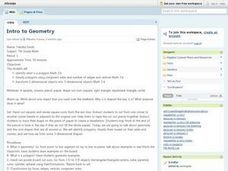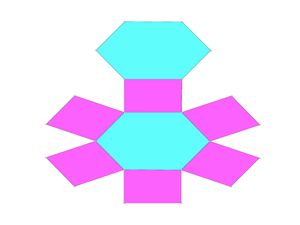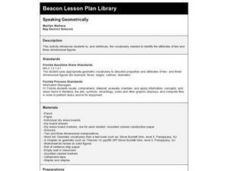Curated OER
Identifying and Classifying Solid Figures
Learners identify solid figures. In this classification lesson, students recognize and name solid figures. Learners identify which figures contain polygons and rectangles. Students practice counting vertices, faces and edges.
Curated OER
Truncated Icosahedron
In this math worksheet, learners build a model of a truncated icosahedron. This shape has 12 regular pentagonal faces and 20 regular hexagonal faces. An option to include a preview of the finished model is included for the teacher.
Curated OER
Truncated Dodecahedron
In this math instructional activity, students build a truncated dodecahedron. This is a solid shape with 12 regular decagonal faces and 20 equilateral triangular faces. Students build this shape to assist in developing their cognitive...
Curated OER
Intro to Geometry
Seventh graders identify a polygon and classify them using congruent sides and number of edges and vertices. Students transform two dimensional objects into three dimensional objects.
Kuta Software
Identifying Solid Figures
Reinforce basic geometry skills in an elementary math lesson. A simple worksheet prompts learners to identify and label 3-D shapes.
Curated OER
Poly-Mania
This hands-on lesson takes young geometers on a tour of 2D polygons and 3D polyhedrons. After exploring different web resources and discussing geometric shapes, small groups construct models of polyhedrons using bendable straws. Note:...
Curated OER
Pyramids and Prisms: Guler's Formula
Sixth graders detect and categorize the attributes of geometric shapes to solve problems. In this geometry lesson, 6th graders construct a variety of polyhedra. Students recognize the relationships between two dimensional and three...
Curated OER
Volume and Surface Area of Right Rectangular Prisms
Learners identify the formulas for three-dimensional figures. They use manipulatives to model problems. Students create foldables and explain volume and surface area. Learners complete worksheets and classify solids. Students sing a...
Curated OER
Writing Takes Shape!
Students read The Greedy Triangle and discuss geometric solids. In this geometry lesson, students list the geo-solids in the world and create a graphic organizer to show where geo-solids exist.
Curated OER
3-D Figures Part 1
Elementary schoolers explore 3-D shapes. They transition from thinking of shapes as only 2-D. Pupils read Cinderella as a launching activity for their upcoming adventure, and explore a new world of 3-D shapes in this introductory...
Curated OER
Searching for Angles and Lines
Young scholars work to find and reinforce concepts related to lines and angles. They identify the characteristics of shapes that have one, two, and three dimensions. The students also work on definitions related to the geometry of shapes.
Curated OER
Solid Figures
Students investigate solids. In this geometry instructional activity, students use toothpicks and gum drops to solve problems. They create visuals to help them see what is happening to the shapes.
Curated OER
Arithmetic Artistry
Students create a classroom quilt that illustrates the many unique ways that students use math skills.
Curated OER
It's a 3-D World Out There!
Young scholars construct polygons. They identify attributes of three-dimensional shapes. Students name common three-dimensional shapes. They draw three-dimensional shapes, and sort three-dimensional shapes. Young scholars use K'NEX...
Curated OER
Make the Shape into a Solid
In this geometry worksheet, students rewrite word problems using symbols and formulas. They calculate the volume of the different solids. There are 8 questions.
Curated OER
Geometry and Tony Smith Sculpture
Students respond to Tony Smith's sculpture as art and brainstorm about math concepts inherent in his work. They create a sculpture with polyhedra nets, calculate the cost of covering sculpture in gold, and write an exhibit label for...
Mathematics Vision Project
Module 5: Modeling with Geometry
Solids come in many shapes and sizes. Using geometry, scholars create two-dimensional cross-sections of various three-dimensional objects. They develop the lesson further by finding the volume of solids. The module then shifts to finding...
Houghton Mifflin Harcourt
Unit 6 Math Vocabulary Cards (Grade 3)
A set of 49 math vocabulary cards ranges from angle to irregular polygon to parallel lines. Each sheet contains two cards: one with the word printed in bold text and the other with the definition.
Old Dominion University
Introduction to Calculus
This heady calculus text covers the subjects of differential and integral calculus with rigorous detail, culminating in a chapter of physics and engineering applications. A particular emphasis on classic proof meshes with modern graphs,...
Curated OER
Speaking Geometrically
Fourth graders are introduced to the vocabulary needed to identify the attributes of two and three-dimensional figures. They work together to create a word wall, which contains the geometric terminology being learned.
Curated OER
Build Solids
In this solid figures worksheet, students use the figures for the cube, pyramid, and rectangular prism to answer the six questions about the characteristics of solid figures.
Curated OER
Copy Cat
Students examine a Webmath page, and demonstrate how to copy and paste. They create a computer-generated template page presenting the attributes of two- and three- dimensional shapes.
Curated OER
What a Shape!
Second graders culminate their study of shapes by describing the shapes using the proper mathematical descriptors.
Curated OER
Give It a Whirl
Students examine and identify polyhedron shapes on a math website. They write journal reflections about two- and three-dimensional shapes, and transform a square into a pinwheel.

























